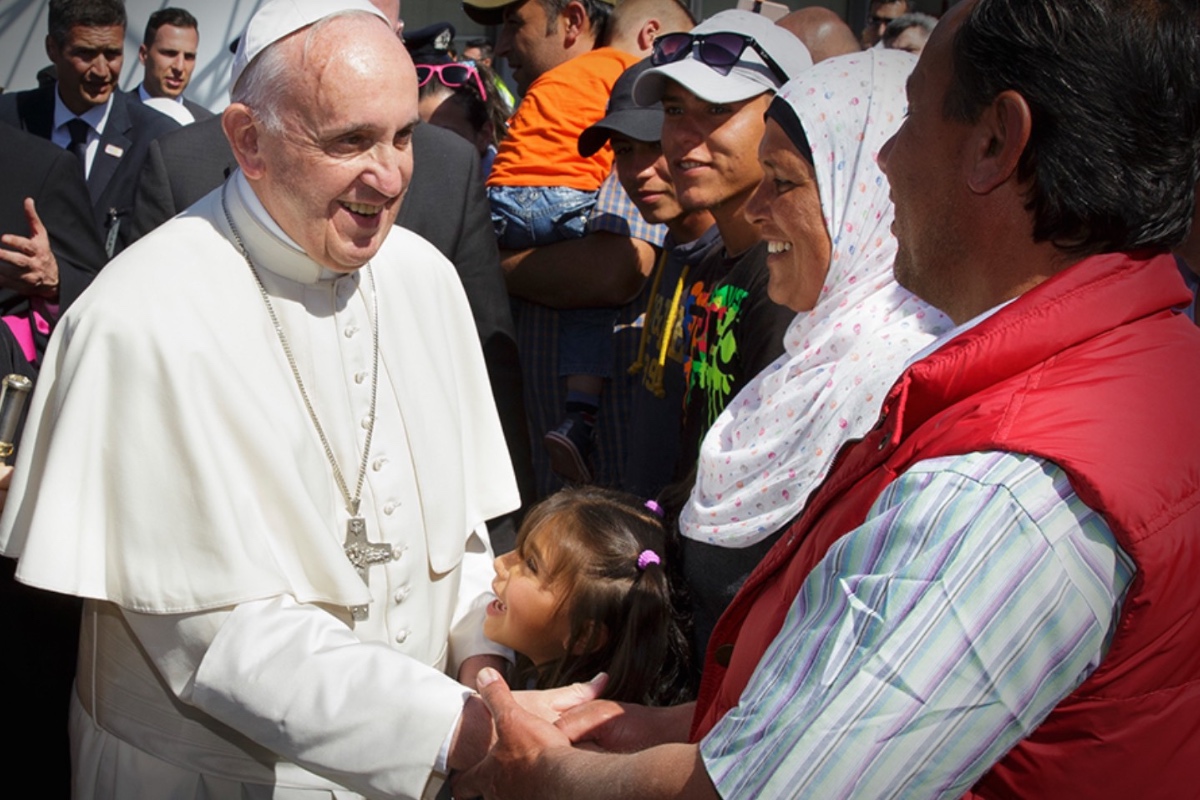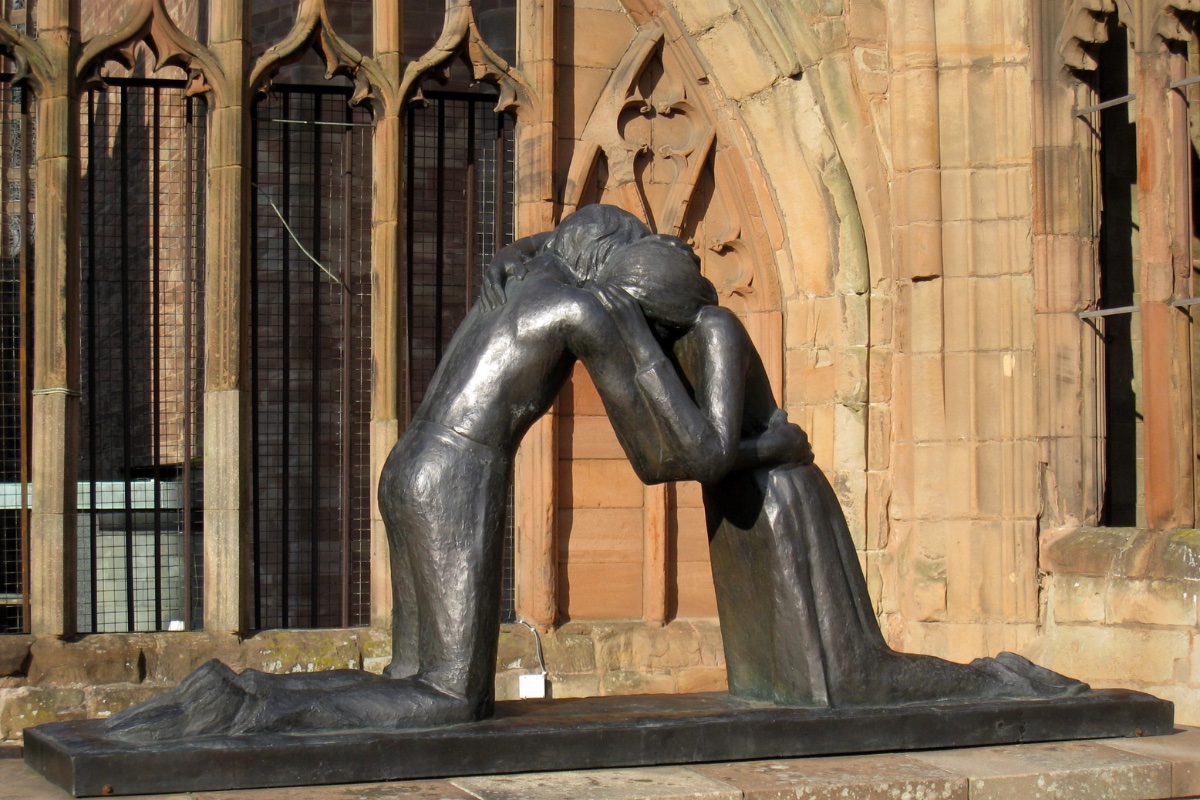From September 22–24, 2024, the Sant'Egidio Foundation for Peace and Dialogue welcomed students from U.S. colleges and universities to join the 38th International Meeting of Religions and Cultures in Dialogue in Paris, France. Ever since Pope John Paul II held the historic World Day of Prayer for Peace in Assisi (1986), Sant'Egidio has taken up the pope's invitation to "continue to live the spirit of Assisi" by proposing an annual international meeting for dialogue between representatives of different faiths and cultures. This event, particularly needed in our current time of international wars, was attended by leading religious, political, and cultural figures.
Boston College (BC) sponsored four students to participate in the event in Paris, France. The students had the opportunity to participate in the high-profile opening and closing ceremonies, and attend panel presentations on a range of topics related to peace, threats to peace, and the role of religions in peacebuilding and reconciliation. Below are some of their reflections on this powerful gathering.
CONOR RICHARDS ’25 recently graduated from BC, majoring in management (with a concentration in finance) and philosophy.
The moment of the conference that surprised me the most were remarks by French President Emmanuel Macron at the opening ceremony. President Macron focused on this year’s theme— Imagining Peace—and how imagination is the only way to a just, lasting peace. Reflecting upon this moment later that night, I wrote in my journal:
“Imagination is an act defined by creation. To imagine peace, then, is to create something new. Peace can never be a return to what was. The solution does not lie in the past; it lies in imagination, creation. However, what is 'new' is always dangerous. In all things, we fear the unknown, and in all places, change is frightening to those in power. Thus, peace itself becomes dangerous, and imagining peace, a radical act. To imagine peace, our first duty is to rehumanize our gaze. We must recognize the right to live of those who were yesterday our enemies. Peace is possible only when we live together, when we speak each other’s languages, both figuratively and literally. Only then can we begin to build something new. This reveals a dual nature to peace that is oft neglected. First, peace must arise interpersonally. No glossy accords can force peace upon a people who do not pursue it in their hearts. Second, peace is a continuous action. Danger arises when we allow peaceful structures to ossify. Macron pointed to NATO and the UN as examples. These organizations were created to address the problems of a post-Second-World- War world. The world is different today—our challenges are different—and to persist in frozen structures is to enforce an unjust order. Each generation must imagine peace anew."
As a Catholic, I understood that the Church across the world was being built through the hidden lives of millions, that the newness of the Gospel must be lived out by us. We are the Church.
NELSON TEIXEIRA DA PEDRA ’26 is a student at BC majoring in theology and political science with a faith, peace, and justice minor.
It can be easy to dismiss the Prayer for Peace as unproductive to ending global conflict or as solely performative. This is not the case. The Prayer for Peace was not intended to be a Treatyof Versailles-esque negotiation that would establish world peace—this is a negative conception of peace that solely understands it as the absence of war. Rather, the Prayer for Peace and the work of Sant’Egidio are intended to demonstrate that regardless of religious or national affiliations, we share a desire to promote peace rooted in the intrinsic value of humanity. The conversations that I witnessed demonstrated that although we may disagree on how to reconcile conflicts, we can plant the seeds via the recognition of basic human dignity. Moments such as hundreds of individuals from across language and cultural barriers embracing each other in the rain, wishing each other “peace” in their own languages, and panels of speakers from all sides of a variety of spectrums holding an implied respect for each other and a desire to end violence, resonated with me.
Through dialogue, we can promote concrete peace. Sant’Egidio has worked to broker peace in Mozambique following a bloody and lengthy civil war and is actively mediating conflicts in South Sudan and the Central African Republic. We can also see the successes of dialogue in the Truth and Reconciliation Commission in post-apartheid South Africa and in themany historical diplomatic successes in de-escalating international tensions. These examples began and ended with words rather than weapons. Though dialogue may not resolve every conflict immediately, the social cooperation and respect demonstrated at the Prayer for Peace exemplifies the groundwork toward peace offered by dialogue.
GRACE SNELL ’27 is a student at BC and a Gabelli Presidential Scholar, majoring in philosophy and Islamic civilization and societies.
We knelt on ancient stone, invoking God to bless each place that was riddled with violence. As we numbered each conflict, I saw the only way not to bow down to the despair of evil was to live out the small suffering of each day and offer that to God in prayer. As we spilled out onto the streets, I stepped out into the head of the procession, inadvertently walking with an ecumenical council: the scarlet zucchetto side by side with the kalimavkion, the black tippet abreast with alabaster klobuks. We each lived out a belief of God in vastly different ways, yet our purpose was one.
As a Catholic, I understood that the Church across the world was being built through the hidden lives of millions, that the newness of the Gospel must be lived out by us. We are the Church. Watching Tibetan monks sign documents with imans and shinshokus, I saw the strengthof religious dialogue, the diversity of ideas and practices creating the impetus for human flourishing.
As I spent the week meeting community members who devoted their lives to marginalized groups, gathering each week to pray for international amity, and then living out Christ’s injunction to “love thy neighbor,” my conception of peace changed into a vision of concord mixing with a robust charity. I heard of London groups starting weekly “schools of peace” for children who had no safe place to go, I listened to stories of homeless friends who had attended Sant'Egidio weddings, I visited a nursing home and saw the epidemic of loneliness amongst the elderly consoled. I saw Christ wherever I went, a Christ who ate with the poor and who transformed tradition into a message of renewal.
JULIA FRANCO ’26 is a student at BC majoring in international studies (with a concentration in cooperation and conflict) and minors in English and faith, peace, and justice.
The Sant'Egidio Prayer for Peace conference provided the community that I didn't know I had always been looking for. I met inspiring and accepting changemakers from all over the world, and still keep in touch with some of them today. Sant'Egidio showed me the meaning of nurturing an international family, and I will forever be grateful for that.
I learned that interfaith peacebuilding and reconciliation requires relationship-building and consistent encounter over time. Sant'Egidio is a fascinating organization because it positions itself in Track 1.5 Diplomacy by sustaining relationships with civil society and interfaith andgovernment leaders. Not only does genuine and strong relationship building occur between Sant'Egidio members themselves, but their peacebuilding work all over the world is characterized by the same high-quality connection and care.
Before the closing ceremony, religious ceremonies from Buddhism, Hinduism, Christianity, Judaism, and Islam were held all over the city. I decided to go to a Cambodian Buddhist ceremony, and I was welcomed in with warm smiles and gestures. This was a beautiful moment for me to learn about and witness a spirituality that was different from my own. While I didn't know the prayers, chants, or how to behave so that I fit in, I reveled in their devoted energy and togetherness. While I may not be Buddhist, I was treated like another beloved member of the human family all the same. I was a participant in Sant'Egidio's interfaith exchange, and it was one of my favorite moments from the conference.
Photo credit/description: Conor Richards. Boston College students at the Sant'Egidio Foundation for Peace and Dialogue's 38th International Meeting of Religions and Culture in Dialogue in Paris (2024).





